Climate Change Ruins The World Championship Sled Dog Derby
7:13 minutes
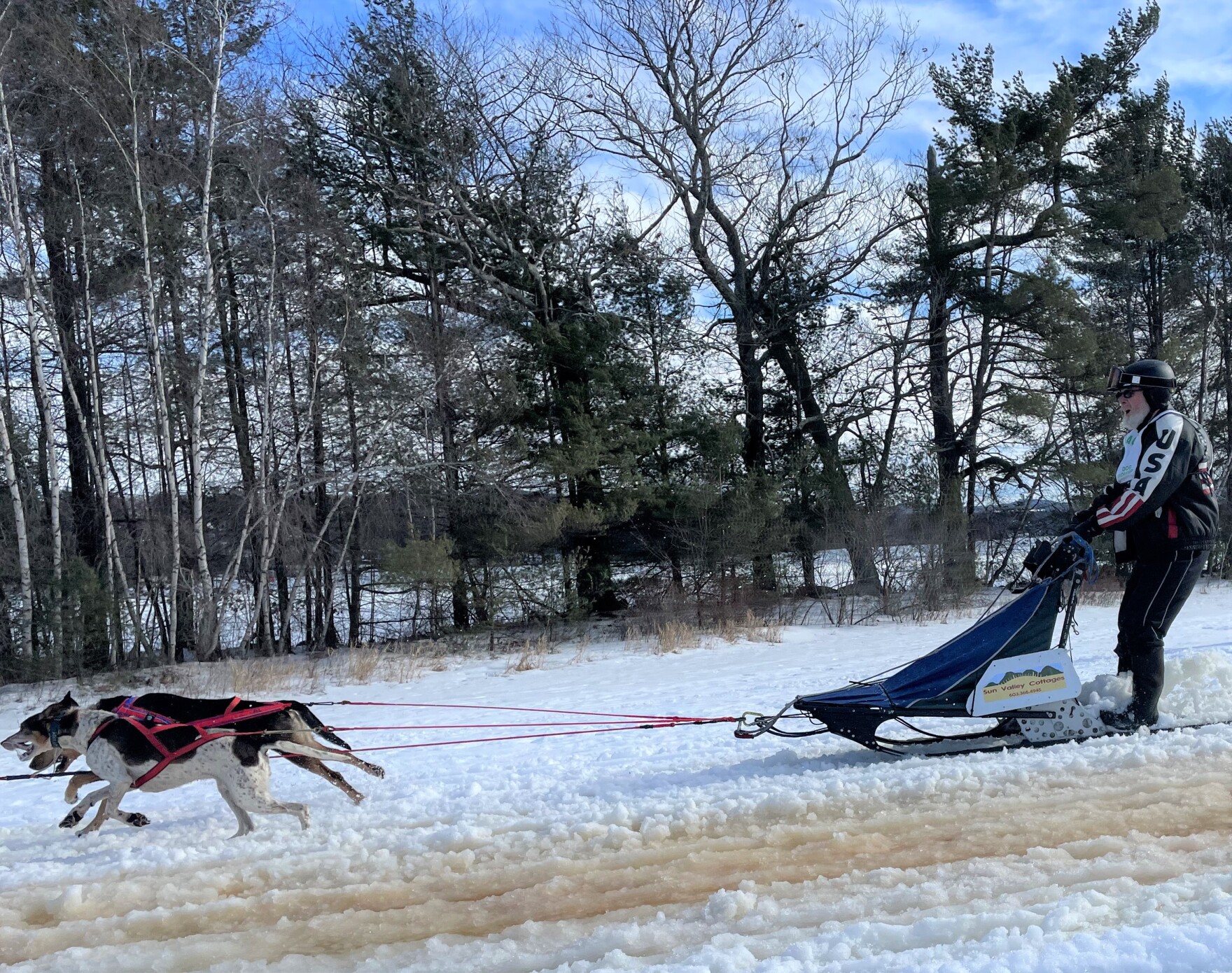
 This article is part of The State of Science, a series featuring science stories from public radio stations across the United States. This story, by Mara Hoplamazian, was originally published on New Hampshire Public Radio.
This article is part of The State of Science, a series featuring science stories from public radio stations across the United States. This story, by Mara Hoplamazian, was originally published on New Hampshire Public Radio.
Teams of sled dogs and mushers from across the United States and Canada visited Laconia this weekend for the 93rd annual World Championship Sled Dog Derby.
Racers were in good spirits, though they faced slushy conditions on Friday and Saturday—a situation that has become more common, many mushers said, as climate change causes winters to warm.
Vince Buoniello was the chief judge for the Laconia race, which has a deep and prestigious history in the sled dog world. He likened it to the Super Bowl.
“Laconia was always a magic name. Everybody wanted to race Laconia,” he said.
Through his 65 years in the sled dog world, Buoniello has seen big changes—fewer people seem to be involved in the sport, and it’s harder to find undeveloped land for sledding trails. And, he said, warming winters have made races difficult to schedule.
“We raced every weekend for years and years. It was an exception if a race ever got canceled. Now, forget it. It’s changed drastically,” he said. “To see mud, it just blows your mind. It just never used to happen.”
Buoniello, who is 90, said judging the race in the warm conditions had tired him out a bit. But, he said, his love for the sport and the animals has made it worthwhile throughout his career.
“The dogs kept me going,” he said. “It was just such love. It was just pure love.”
Jules Struzyna, a musher from Vermont, said it’s not just the mushers who love the sport.
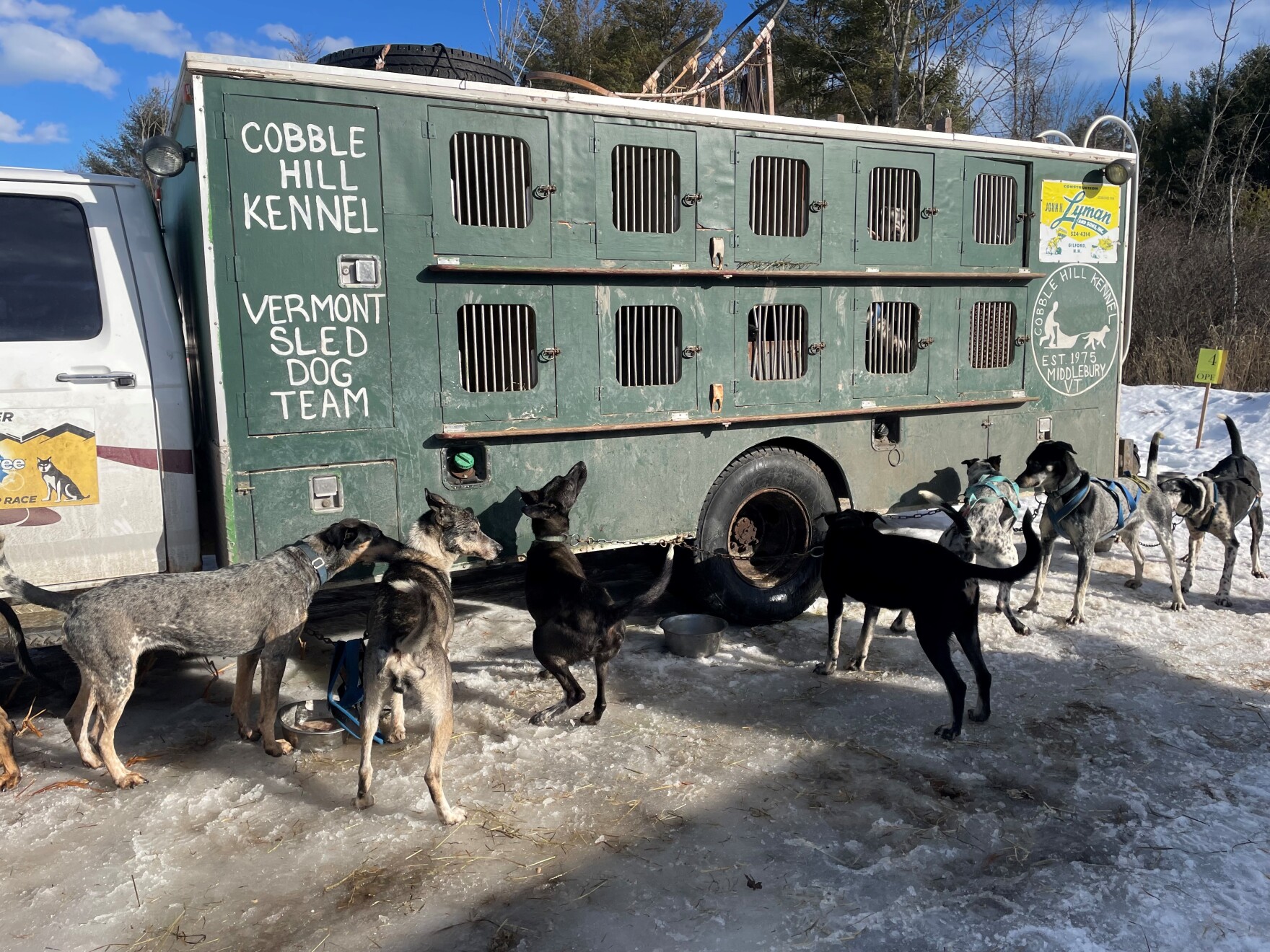
“We love to do it, obviously, but not even a fraction as much as the dogs,” they said.
Struzyna said they and their dogs have seen the effects of climate change on the sport. For their team, race days have been few and far between – but that made getting out over the weekend all the better.
“If we can get a race in, that’s great,” they said. “Some years we don’t get any….so we’re stoked to just be out here racing and having a good time.”
But the trail was slow going this weekend. It’s harder for dogs to run on slush, Struzyna said. One race on Saturday was moved to start half an hour earlier to avoid more melting.
And Sunday’s events were canceled, after a cold night turned the slush and water to ice, creating unsafe conditions for dogs and humans.
Struzyna’s team comes from the Cobble Hill Kennel in Vermont, where the dogs take tourists out for runs, using a cart with wheels when there isn’t enough snow to use a sled. But the dogs like racing the best, Struzyna said.
At the starting line, each team of dogs met spectators with a chorus of excited yelps. An ATV, sled brakes, and multiple humans were required to keep the dogs from racing off before the starting call.
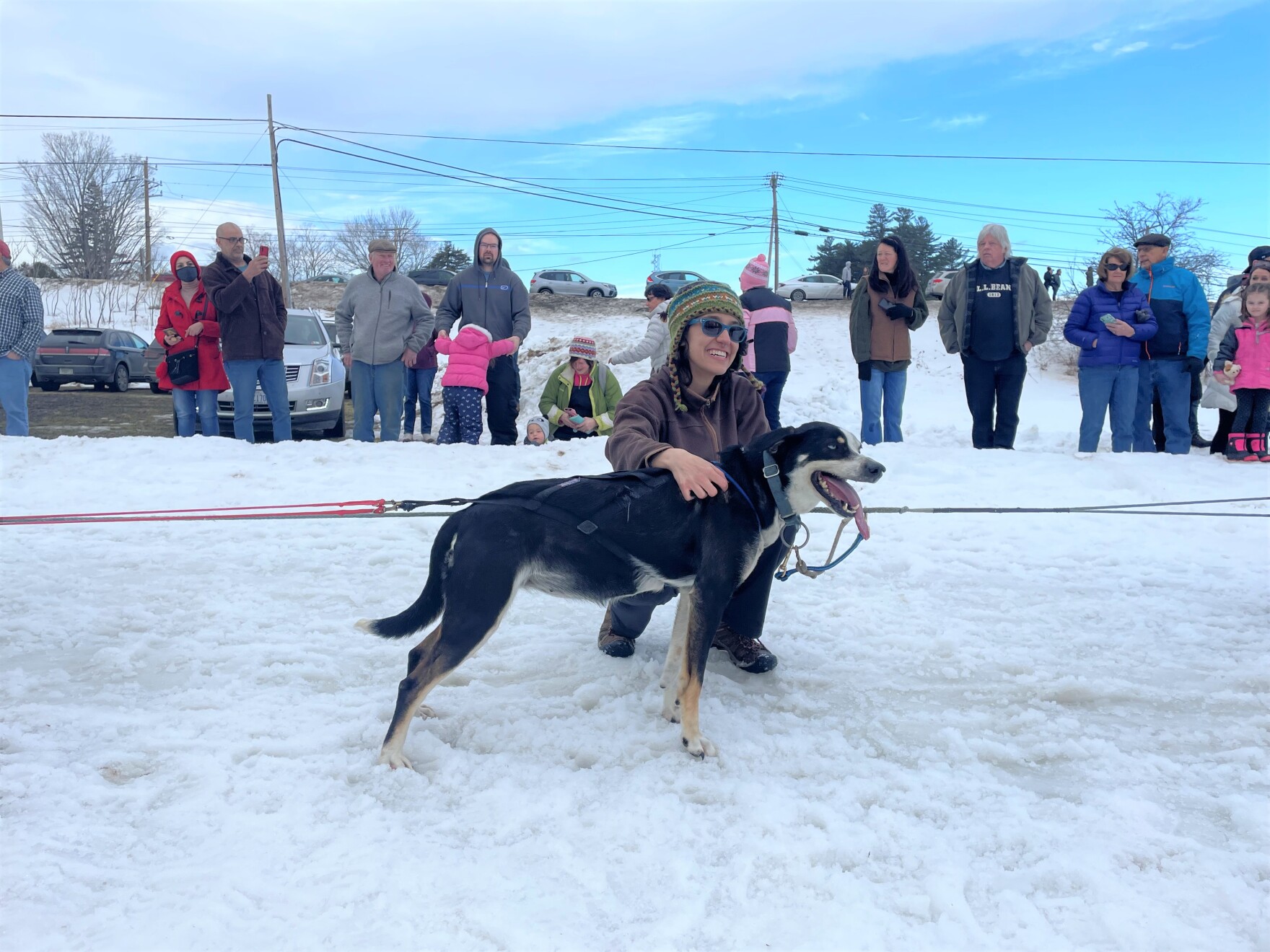
Handlers rubbed snow onto some dogs to cool them off.
Sally Manikian, a musher from Shelburne, said warmer conditions can overheat her dogs. “The dogs get hot, like anyone. It’s sort of like running a marathon when it’s 100 degrees and humid,” she said.
She started her race with dogs Flora and Cobalt in the lead, but switched Cobalt out after the stress of race day proved too much for the pup. But for Manikian, that was the point—she wanted to get her young team acclimated to the feeling of a crowded race.
“There’s a lot of spectators,” she said. “That’s why I signed up.”
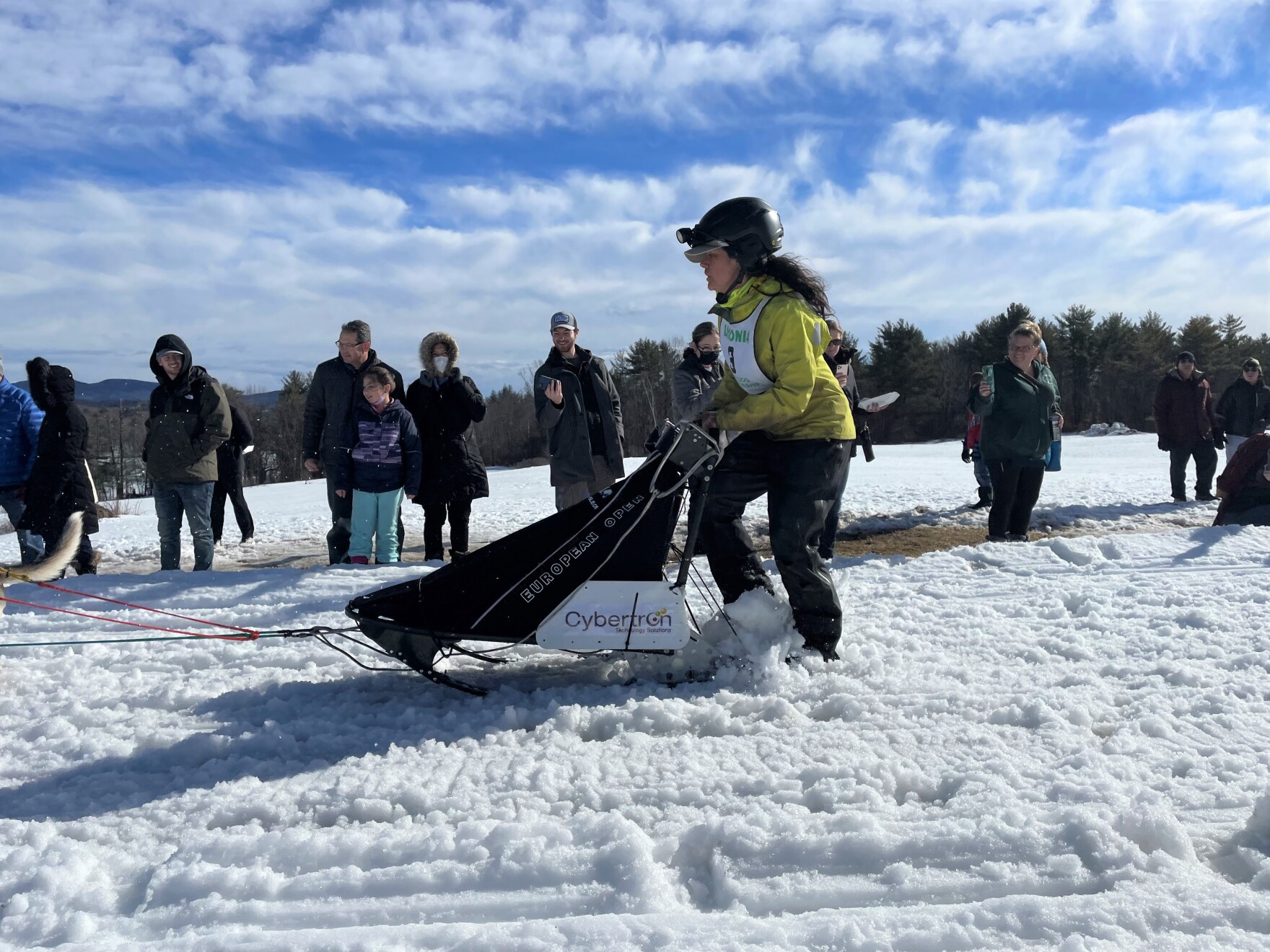
Fernando Ramirez brought his dog team to New Hampshire from Utah.
“World Championships is definitely one of those prestige races that really tests your team to see how you rank with the best mushers in the world,” he said.
Ramirez keeps track of temperature and snow conditions each year while training his dogs in Utah. And he’s seen big changes there too, especially in the past five years. He used to be able to start training in September, but temperatures aren’t getting low enough to start until mid-October now. The end of the season comes quicker, too.
“I have it in all my training logs. We’re pretty much off our sleds in February,” he said. “In Park City, to see the snow melt and become “unrunnable” in February, it’s really strange…If we have a really good snow year, it’s what our average snow years used to be like.”
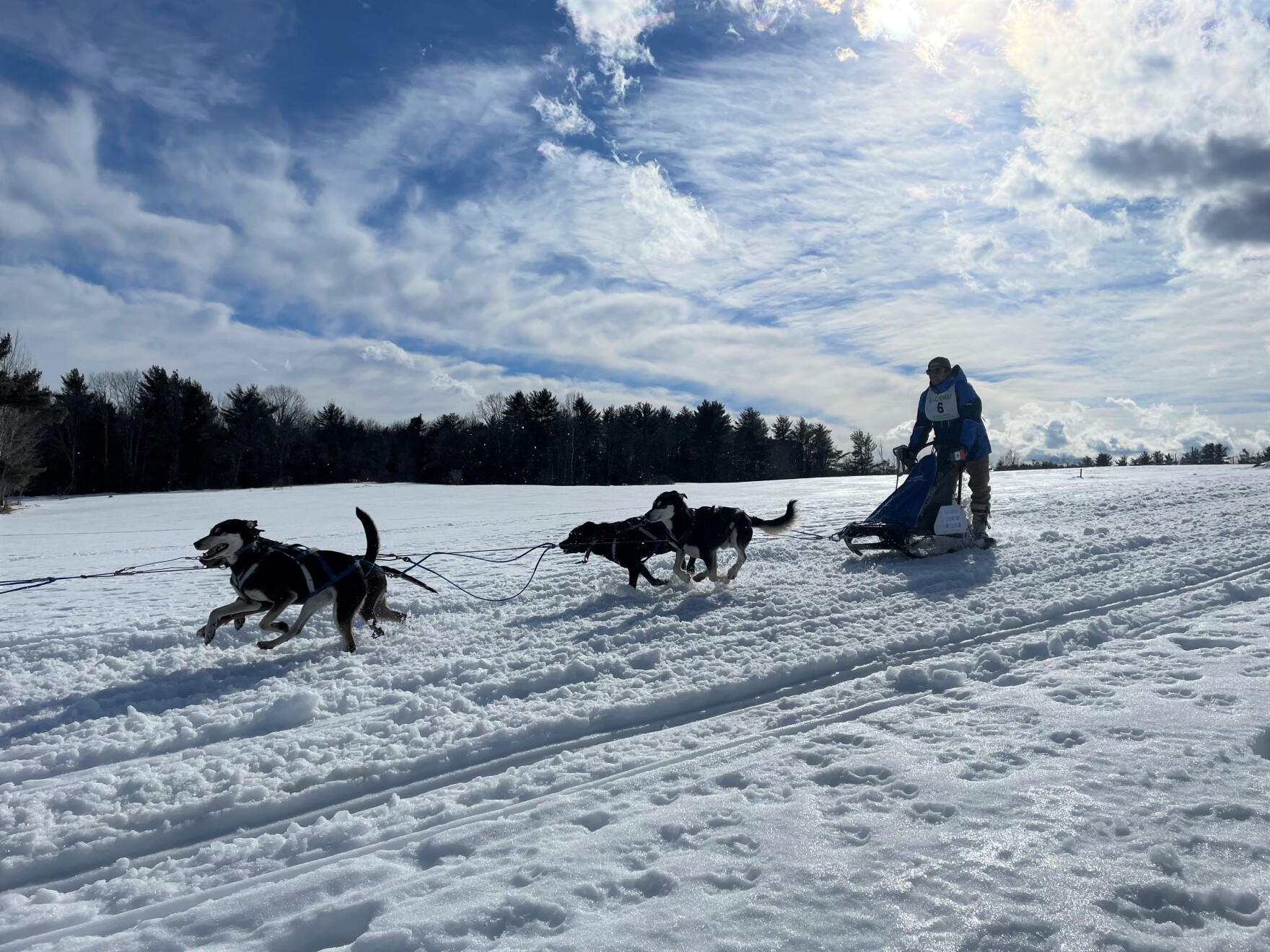
In Quebec, the training season has also been affected by climate, said Guy Girard, a musher from St. Thomas de Joliette, whose team won the open class events on Friday and Saturday.
This year, COVID-19 presented an additional challenge for Canadian teams. Girard and his friend Jean-Phillippe Lacasse, a musher from Gaspe, were able to make it, but quarantine restrictions and the risk of transmission caused others to stay away.
“Some mushers, they have to go to work on Monday,” he said. “They cannot stay here two more weeks because they have a positive test. Even if they really take care—you never know.”
For the hundreds of spectators watching the event, mud didn’t get in the way of a good time. But many seemed aware of how warming winters in New Hampshire are changing the landscape of recreation.
Merry Fortier, who now lives in Canterbury, grew up watching dog sledding events in Tamworth—a race that’s also experiencing changes due to warming winters. She says the changing climate has changed her experience as a spectator, too.
“Now that the climate is different, it’s harder and harder for these events to be in New Hampshire,” she said. “Just not enough snow, or snow and then rain, which doesn’t work well for the dogs and the drivers.”
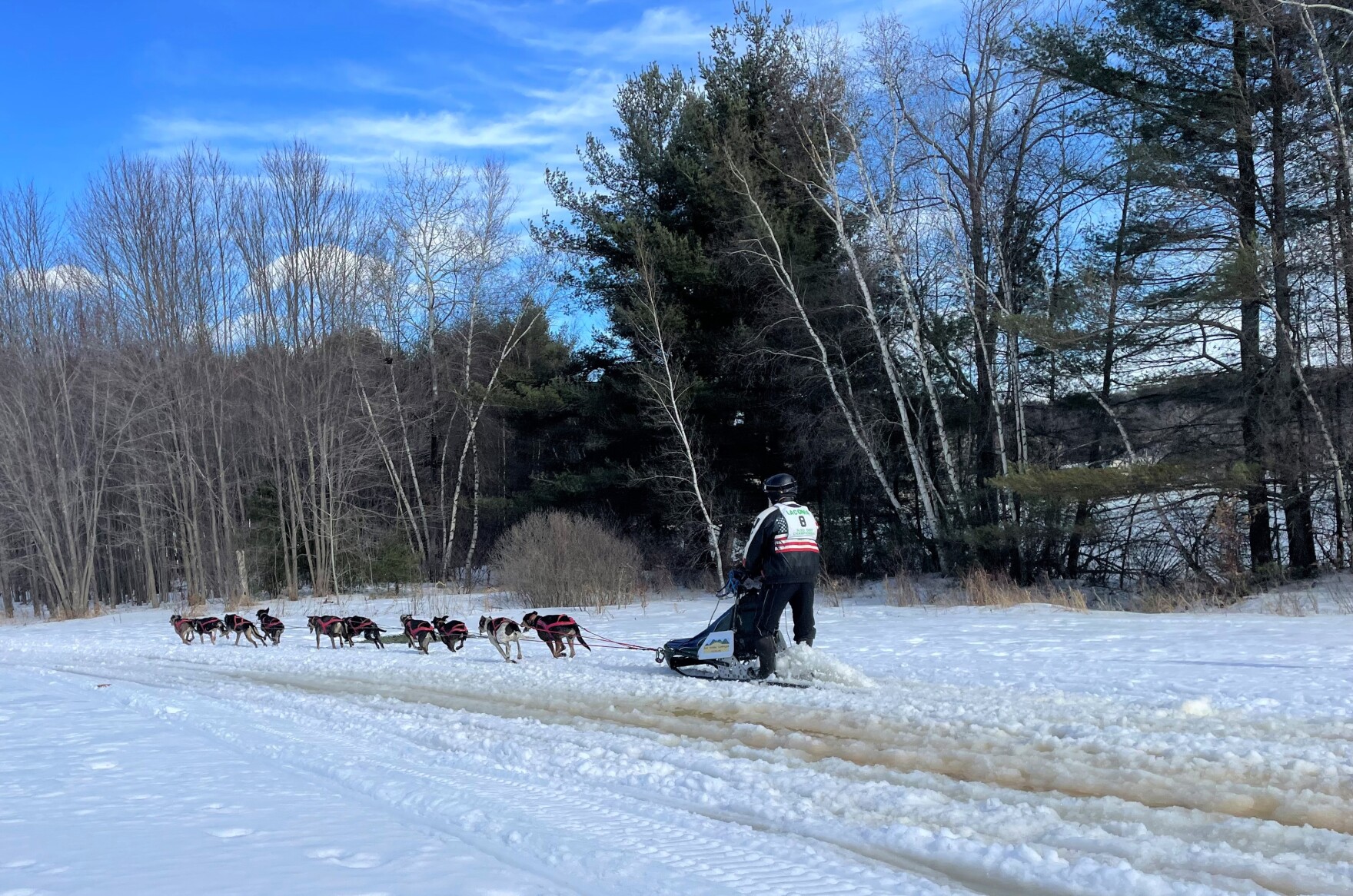
But even with the mud, the Laconia world championship was an exciting event, she said.
“It’s just a really fun, joyful thing to watch, to watch the dogs and their teams go out and be outside and just have a beautiful day.”
And winter sports are meaningful not just to the racers, but to the communities that host them. Kayla Bradshaw, who moved to Laconia last year, said the event showed her the beauty of the community in the Lakes Region—something that helps make winter a little easier.
“It’s amazing to see everyone come out and support each of these events—ice fishing last week, and here today with the sled dog derby,” she said. “There’s always something going on in the winter to keep you going.”
Invest in quality science journalism by making a donation to Science Friday.
Mara Hoplamazian is a climate change reporter at New Hampshire Public Radio in Concord, New Hampshire.
JOHN DANKOSKY: This is Science Friday. I’m John Dankosky. And now it’s time to check in on the state of science.
SPEAKER 1: This is KERA–
SPEAKER 2: For WWNO–
SPEAKER 3: St Louis Public Radio.
SPEAKER 4: Iowa Public Radio News.
JOHN DANKOSKY: Local science stories of national significance. Laconia, New Hampshire is home to the World Championship Sled Dog Derby. It’s a sport where teams of sled dogs and mushers race across the snow to see who’s the fastest. But, like many things, a warming planet is changing this sport. Many longtime enthusiasts say that change is for the worse.
Joining me today is a reporter who’s been covering the story. Mara Hoplamazian is climate change and environment reporter for New Hampshire Public Radio, based in Concord, New Hampshire. Welcome to Science Friday, Mara.
MARA HOPLAMAZIAN: Thanks so much, John. Thanks for having me.
JOHN DANKOSKY: So how long have sled dog teams gathered in Laconia for this race?
MARA HOPLAMAZIAN: So this is the 93rd year of this event. The first races were held in 1929. So it’s been around longer than the Iditarod, which I think is what many people think of when they think of dog sledding.
The race was started a few years after the famous sled dog run to Nome Alaska, where sled dog teams brought that community diphtheria medication. And one of the mushers who did that run to Nome actually won the first race in Laconia, so it has that history. World Championships was added to the name in 1936. And mushers at this year’s event said it’s lived up to that title. It’s one of the biggest races outside of Alaska.
And one musher told me it’s really the event to race in to see how you compare to some of the best mushers in the world, who come from all over the US and Canada to compete. The chief judge compared it to the Super Bowl of sled dog racing.
JOHN DANKOSKY: Wow, so this is a really big event and it’s got quite the history. So maybe you can paint a picture for us of what this year’s event was like.
MARA HOPLAMAZIAN: Yeah, sure. It was warm. On Saturday, the sun was out, the snow started melting early in the day. Spectators were navigating a lot of mud. My boots got stuck. Right next to the starting line, mushers from across the US and Canada park their trailers with a bunch of dogs, and get them ready to race. Getting eight or nine or 10 super-excited dogs into harnesses seemed like a really difficult task.
Teams went out one by one and so as the announcer was sort of counting down towards the starting call, a team of handlers actually had to hold back the dogs, because as soon as they got on the snow they’re really ready to run. But there were three events on Saturday: the six-dog classic, three-dog junior race, and an open class race, where mushers have different numbers of dogs.
They’re all sprint events, so the times for the six-dog classic were sort of in the 15 minute range, which was fun to see the racers go out and come back pretty quickly. And then the times for the open event we’re in the 45 minute range. It’s really a different scale than a race like the Iditarod, where teams are taking multiple days to complete the race. It’s a sprint for the dogs and for the mushers.
JOHN DANKOSKY: So this race has been going on for a very long time. I can imagine that an awful lot has changed over the course of 93 years. What did some of the people that you talked to say about how this event has been changing over the last few decades?
MARA HOPLAMAZIAN: Yeah, it does seem like a lot has changed. So I talked to Vince Bonello, who was the chief judge for the event. He’s 90. He’s been part of this for 65 years, as a musher and also as a judge. And he said he’s seen a lot of changes to the sport. There’s less teams involved. There’s less undeveloped land to create trails on, he said. And climate change has really changed how the races look.
VINCE BONELLO: We raced every weekend for years and years, with the exception if the race never got canceled. Now, forget it, it’s changed drastically. The sea mud. It’s just blows your mind.
MARA HOPLAMAZIAN: Other mushers said the same. There used to be dozens of races per season, one of them told me. But with warming winters, snow conditions are harder to predict and they just don’t hold up like they used to.
The local paper in Laconia reported that in its first 50 years the race was only canceled once due to a lack of snow in 1974. But since the 1980s it’s been canceled 13 times, and that’s about once every three years. So the racing conditions really are changing.
JOHN DANKOSKY: When you talk about mud, people in New England think about mud season, which is supposed to start when spring comes. But you’re talking about mud here actually in the winter. Just so the people have a sense of this, Mara, Laconia, New Hampshire isn’t way up by the Canadian border. It’s not as far north as the Iditarod in Alaska. It’s pretty much smack dab in the middle of New Hampshire. So the winters are kind of Boston-like in a lot of ways.
MARA HOPLAMAZIAN: Yeah, definitely. It’s in the Lakes region, so not way up far north.
JOHN DANKOSKY: So how has training changed for people who are involved in the sport, given all the changes to the weather?
MARA HOPLAMAZIAN: Yeah, so, mushers told me that the changing climate has shortened the amount of time per year that they can train. Mushers from across the world told me that. So a musher from Utah, Fernando Ramirez, told me he can see climate change actually appearing in his training log.
FERNANDO RAMIREZ: We used to have really good weather. Winters were really consistent. We’d have off years here and there, but nothing to what we’re seeing now. The past five years, and I have it in all my training logs, to see the snow melt and become “unrunable,” quote, quote, in February, it’s really strange. Normally we were able to do that in March, early April.
JOHN DANKOSKY: But it’s interesting hearing from Fernando that the training is a problem in Utah too. It’s not just New Hampshire that’s having problems with less and less snowfall over the years, it’s also Utah. So how does this impact the dogs? That’s what a lot of us care about. Is it bad for them?
MARA HOPLAMAZIAN: Right, so one of my big takeaways from this race was what a deep connection these mushers have with their dogs. And when I asked about how climate change was affecting their training season or the races, mushers would talk about how their dogs are experiencing climate change. Sally Manikian is a musher from Northern New Hampshire, and she told me that the heat can be really hard for her dogs.
SALLY MANIKIAN: The dogs get hot, like anyone. It’s sort of like running a marathon when it’s 100 degrees and humid. So you have to go slower, or I try to go slower. The snow is softer, so they work twice as hard. So it’s hotter and softer, so it’s kind of like a double bind.
MARA HOPLAMAZIAN: And the dogs really seem to love racing. And so this loss of race days to warmer winters is creating a loss for these dogs, too, who are really trained athletes in the sport.
JOHN DANKOSKY: How has this warming weather impacted the other winter sports in New Hampshire? Because, as you said, it really is a big part of the tourism economy. It’s a really big part of life in New Hampshire, having a real winter.
MARA HOPLAMAZIAN: Well, skiing is what a lot of people talk about. Downhill areas can make snow, but it can be really hard for Nordic skiers who can’t get that help. But there’s a lot of other things that are affected, too. Recently the town of Hanover in New Hampshire canceled their annual winter festival that had been going on for 25 years. For good. It’s this big community event that’s usually held on a frozen pond. And they just said with winter conditions so unpredictable and warming they can’t hold an event that relies on frozen ice.
JOHN DANKOSKY: So many changes to winter weather with climate change. That’s all the time we have for now. I’d like to thank my guest, Mara Hoplamazian, as climate change and environment reporter for New Hampshire Public Radio based in Concord, New Hampshire. Mara Thanks so much.
MARA HOPLAMAZIAN: Thank you so much, John.
JOHN DANKOSKY: And if you want to see pictures of some of the dogs and the human racers at this year’s derby, you can go to our website, sciencefriday.com.
Copyright © 2022 Science Friday Initiative. All rights reserved. Science Friday transcripts are produced on a tight deadline by 3Play Media. Fidelity to the original aired/published audio or video file might vary, and text might be updated or amended in the future. For the authoritative record of Science Friday’s programming, please visit the original aired/published recording. For terms of use and more information, visit our policies pages at http://www.sciencefriday.com/about/policies/
Kathleen Davis is a producer and fill-in host at Science Friday, which means she spends her weeks researching, writing, editing, and sometimes talking into a microphone. She’s always eager to talk about freshwater lakes and Coney Island diners.
John Dankosky works with the radio team to create our weekly show, and is helping to build our State of Science Reporting Network. He’s also been a long-time guest host on Science Friday. He and his wife have three cats, thousands of bees, and a yoga studio in the sleepy Northwest hills of Connecticut.